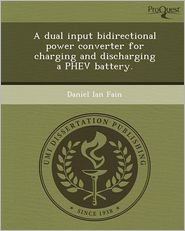
This thesis looks at a new design for a dual input bidirectional power converter (DIBPC) for charging and discharging a PHEV battery. The design incorporates a power factor correcting rectifier aimed at optimizing the battery charging efficiency from either a 120 VAC or 240 VAC source or discharging the battery to a usable AC voltage at 120 VAC. For simplicity and cost-effectiveness, the DIBPC is constructed using a standard IGBT 6-pack intended for motor control. The DIBPC is designed specifically to provide efficient operation with 120 VAC and 240 VAC inputs while achieving a very low THDI. The DIBPC also needs to be able to provide AC output power at 120 VAC with the flexibility to output at 240 VAC in the future.;The DIBPC was tested first in simulation, and then in experimentation. The DIBPC consists of two portions, an AC/DC converter and a DC/DC converter. Although both were simulated, only the AC/DC converter was constructed. Testing under various load values and in each mode of operation provided ample data to show the DIBPC can meet all design goals.;When operating as a rectifier, the DIBPC produces between 7.4% and 13.35% THDI and a DC voltage ripple of 8 VP-P or less at 400 VDC. At 120 VAC and 240 VAC an efficiency of 84.5% and 94.6% was achieved, respectively. When operating as an inverter, the DIBPC produces less than 6% THDV and 7% THDI, while outputting a voltage between 114 and 128 VRMS. Overall, the THD I in the charging mode easily meets and exceeds all standards and design constraints set forth, including IEC 61000-3-4. The efficiency with a 120 VAC input, however, is less than expected -- about 84%.
|